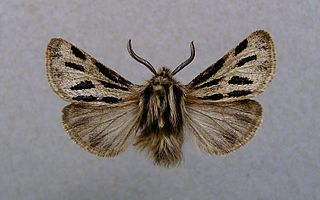
The skimmers or perchers and their relatives form the Libellulidae, the largest dragonfly family in the world. It is sometimes considered to contain the Corduliidae as the subfamily Corduliinae and the Macromiidae as the subfamily Macromiinae. Even if these are excluded, there remains a family of over 1000 species. With nearly worldwide distribution, these are almost certainly the most often seen of all dragonflies.

Jean Baptiste Alphonse Déchauffour de Boisduval was a French lepidopterist, botanist, and physician.

Jules Pierre Rambur was a French entomologist.

Pyrgus is a genus in the skippers butterfly family, Hesperiidae, known as the grizzled skippers. The name "checkered" or "chequered skipper" may also be applied to some species, but also refers to species in the genera Burnsius and Carterocephalus. They occur in the Holarctic with an additional group of species extending to the Neotropic.

The insect family Coenagrionidae is placed in the order Odonata and the suborder Zygoptera. The Zygoptera are the damselflies, which although less known than the dragonflies, are no less common. More than 1,300 species are in this family, making it the largest damselfly family. The family Coenagrionidae has six subfamilies: Agriocnemidinae, Argiinae, Coenagrioninae, Ischnurinae, Leptobasinae, and Pseudagrioninae.

Tramea is a genus of dragonflies in the family Libellulidae, the skimmers and perchers. Species of Tramea are found in tropical and subtropical regions around the globe. They typically have colored bases to their otherwise translucent hindwings. In particular when they fly, this creates the impression of their carrying bags at the start of their abdomens. They are known commonly as saddlebags or saddlebags gliders.

Apaidia is a genus of moths in the subfamily Arctiinae. The genus was erected by George Hampson in 1900.

Ocnogyna is a genus of moths in the family Erebidae from western Eurasia. The genus was erected by Julius Lederer in 1853. One aberrant species, Ocnogyna parasita, has females with non-functional wings, and because of this was formerly placed in its own genus Somatrichia, but is now in Ocnogyna.
Clethrogyna is a genus of tussock moths in the family Erebidae. The genus was described by Rambur in 1866.

Carterus is a genus of beetles in the family Carabidae, containing the following species:

Melanargia is a genus of butterflies belonging to the family Nymphalidae and the subfamily Satyrinae.

Zygaena punctum is a species of moth in the family Zygaenidae. It is found in Poland, the Czech Republic, Slovakia, Austria, Slovenia, Italy, the Balkan Peninsula, Moldova, Ukraine, Russia and Turkey.

Apaidia mesogona is a moth of the family Erebidae first described by Jean Baptiste Godart in 1824. It is found in Western Europe, Sardinia, Corsica and North Africa.

Coscinia bifasciata is a moth of the family Erebidae. It was described by Jules Pierre Rambur in 1832. It is found on Corsica and Sardinia.
Ocnogyna corsicum is a moth of the family Erebidae. It was described by Jules Pierre Rambur in 1832. It is found on Corsica and Sardinia. The habitat consists of grasslands, pastures, maquis, forest edges and mountain slopes.











